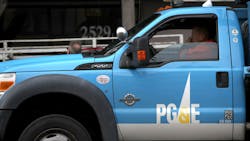Nearly 400,000 PG&E Customers Impacted by Wind Storm
More than 800 Pacific Gas and Electric Company (PG&E) personnel, including electric and vegetation management crews in the field, worked to prepare for and respond to outages and damage from the strong wind event on Feb. 9.
From the time the winds started blowing early Feb. 9 morning through Feb. 10 afternoon, PG&E had restored power to nearly 400,000 customers whose connections had been snapped by winds and flying debris. At 2 pm on Feb. 10, about 12,000 customers remained without power, mostly in the East Bay and along the Central Coast. Crews continued to work to make the needed repairs to restore power to all customers.
The National Weather Service had issued wind advisories and PG&E’s own meteorologists had forecasted an extended period of high winds going into the Feb. 8-9 weekend. PG&E issued a news release on Feb. 7 to help prepare customers.
High Winds Across PG&E’s Network
On Feb. 9, notable higher-terrain wind gusts were recorded at various weather stations: Pine Flat Road in Sonoma County (90 mph), Mt. St. Helena in Napa County (87 mph), Mt. Umunhum in Santa Cruz County (72 mph) and Grizzly Peak in Alameda County (62 mph). Notable low-elevation wind gusts were recorded at Oakland International Airport (53 mph), Fairfield (52 mph), Hayward (49 mph), Livermore (48 mph), Stockton (48 mph), Concord (47 mph) and Vacaville (46 mph). The National Weather Service reported a 125-mph gust at Alpine Meadows in Tahoe.
The high winds caused damage throughout PG&E’s service area, much of it from falling trees and flying branches and debris. PG&E activated 17 local emergency centers and moved crews to areas hit hardest by the strong winds to facilitate restoration. As crews were called to locations where outages had occurred, they found damage including hundreds of downed spans of power lines and dozens of broken poles, crossarms and transformers.
A PSPS Was Not Called
Although the wind speeds were similar to what was experienced last October, the conditions did not meet the thresholds for calling a Public Safety Power Shutoff as fuel and soil moisture values remain high enough to mitigate wildfire danger.
No single factor drives a Public Safety Power Shutoff as each situation is unique. PG&E reviews a combination of many criteria when determining if power should be turned off for safety. These factors generally include but are not limited to:
- A Red Flag Warning declared by the National Weather Service
- Low humidity levels, generally 20% and below
- Forecasted sustained winds generally above 25 mph and wind gusts in excess of approximately 45 mph, depending on location and site-specific conditions such as temperature, terrain and local climate
- Condition of dry fuel on the ground and live vegetation (moisture content)
- On-the-ground, real-time observations from PG&E’s Wildfire Safety Operations Center and observations from PG&E field crews
